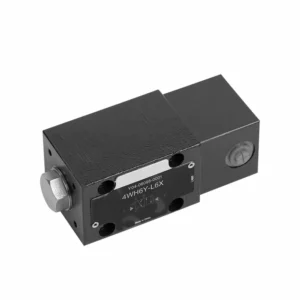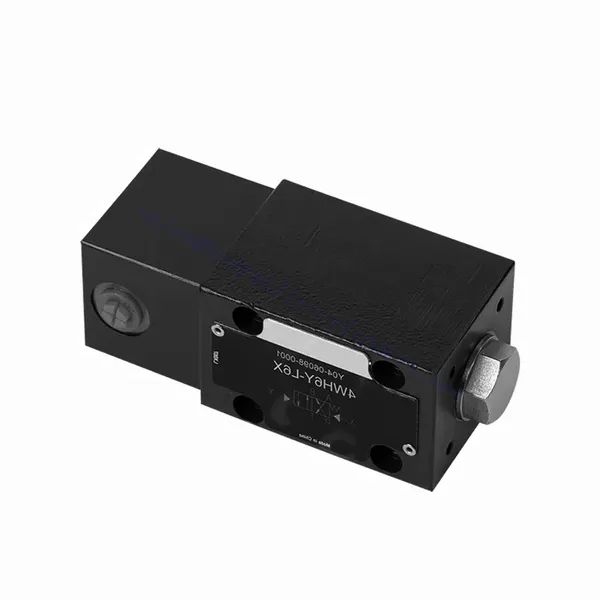WH(D) Series Directional Hydraulic Valve With Fluidic Actuation
유압 실린더 제조업체, 공급 업체 및 기계 제품 수출 업체 중 하나로서 유압 실린더 및 기타 여러 제품을 제공합니다.
자세한 내용은 당사에 문의해 주세요.
메일:sales@hydraulic-cylinders.net
유압 실린더 제조업체 공급 업체 수출.
WH(D) Series Directional Hydraulic Valve With Fluidic Actuation

The WH(D) series directional hydraulic valve with fluidic actuation is a state-of-the-art product designed to provide precise control and efficient operation in hydraulic systems. With its advanced features and reliable performance, this valve offers enhanced functionality and versatility.
The WH(D)series directional hydraulic valve with fluidic actuation offers advanced control and efficiency for hydraulic systems. Its fluidic actuation mechanism, precise directional control, and high flow capacity enhance functionality and versatility. Following the recommended usage methods and adhering to regular maintenance practices, the WH(D) series valve will continue delivering efficient and reliable operation. Upgrade your hydraulic system with the WH(D) series directional hydraulic valve and experience the benefits of enhanced control and efficiency.
WH(D) Series Directional Hydraulic Valve With Fluidic Actuation Key Characteristics:
- Fluidic Actuation:
- The WH(D) series valve utilizes fluidic actuation, allowing for precise and responsive fluid flow control within hydraulic systems.
- This actuation method offers improved accuracy and efficiency compared to traditional mechanisms.
- Directional Control:
- This hydraulic valve enables precise directional control of fluid flow, allowing operators to select the desired flow path easily.
- Directing the hydraulic fluid to the appropriate actuators or components ensures efficient and reliable operation.
- High Flow Capacity:
- The WH(D) Series Valve is designed to handle high flow rates, making it suitable for applications that require substantial fluid flow.
- Its robust construction and optimized internal passages ensure smooth flow and minimal pressure drop.
- Versatility:
- This valve is highly versatile and can be used in various industries and applications, such as manufacturing, construction, agriculture, etc.
- It can be integrated into hydraulic systems that require precise control and efficient fluid management.
WH(D) Series Directional Hydraulic Valve With Fluidic Actuation Parameter:
NG6
| Installation position | Optional | ||
| Fluid temperature range | ℃ | -30 to +80 (NBR seals) | |
| -20 to +80 (FKM seals) | |||
| Port Max. operating pressure | Port A B P | bar | 315 |
| Port T | bar | 60 | |
| Max. flow-rate | L/min | 60 | |
| Flow cross section (switching neutral position) | Q type | mm2 | For symbol Q, 6% of the nominal cross-section |
| W type | mm2 | For symbol W, 3% of the nominal cross-section | |
| Fluid | Mineral oil; Phosphate ester | ||
| Viscosity range | mm2/s | 2.8 to 500 | |
| Degree of contamination | Maximum permissible degree of fluid contamination: Class 9. NAS 1638 or 20/18/15, ISO4406 | ||
| Weight | kg | 1.4 | |
NG10
| Installation position | Optional | ||
| Fluid temperature range | ℃ | -30 to +80 (NBR seals) | |
| -20 to +80 (FKM seals) | |||
| Port Max. operating pressure | Port A B P | bar | 315 |
| Port T | bar | 60 | |
| Max. flow-rate | L/min | 120 | |
| Flow cross section (switching neutral position) | V type | mm2 | 11(A/B → T);10.3(P → A/B) |
| W type | mm2 | 2.5(A/B → T) | |
| Q type | mm2 | 5.5(A/B → T) | |
| Fluid | Mineral oil; Phosphate ester | ||
| Viscosity range | mm2/s | 2.8 to 500 | |
| Degree of contamination | Maximum permissible degree of fluid contamination: Class 9. NAS 1638 or 20/18/15, ISO4406 | ||
| Weight | kg | 4 | |
WH(D) Series Directional Hydraulic Valve With Fluidic Actuation Advantages:
• Direct-acting directional slide valve direct-acting directional slide valve
• Scroll wheel can rotate 90°
• Nineteen standard slide valve functions
Usage Method Of WH(D) Series Directional Hydraulic Valve With Fluidic Actuation:
- System Integration:
- Identify the optimal location for the WH(D) series valve within the hydraulic system, considering the desired flow path and control requirements.
- Ensure compatibility with the system’s pressure and flow specifications.
- Mount the valve securely using appropriate brackets or mounting accessories.
- Fluid Connections:
- Select compatible hydraulic fittings and hoses for secure and leak-free connections.
- Follow the manufacturer’s instructions for proper torque values during the installation process.
- Use appropriate thread sealants or tape to ensure reliable seals.
- Actuation:
- Familiarize yourself with the fluidic actuation mechanism of the valve and understand the control methods available.
- Connect the actuation lines to the designated ports, ensuring proper identification and connection integrity.
- Control and Adjustment:
- Employ the recommended control method, such as manual levers, solenoid valves, or other actuation devices, to operate the WH(D) Series Valve.
- Adjust the valve settings according to the desired flow direction and flow rates, ensuring optimal performance.
How A Hydraulic Valve Works?
A hydraulic valve is a critical component in a hydraulic system that controls the flow and direction of hydraulic fluid. It allows operators to regulate the movement and pressure of the liquid, enabling precise control over various hydraulic functions. Here’s a simplified explanation of how a hydraulic valve works:
- Valve Structure:
- A hydraulic valve typically consists of a valve body, which houses various internal components such as ports, chambers, and passages.
- The valve body also contains movable parts, such as spools or poppets, which control the flow of hydraulic fluid.
- Fluid Flow:
- Hydraulic valves have multiple ports that connect to different sections of the hydraulic system.
- The hydraulic fluid enters the valve through an inlet port and flows through internal passages within the valve body.
- Spool or Poppet Movement:
- A spool or poppet mechanism controls the movement of the hydraulic valve.
- The spool is a cylindrical component with lands or grooves machined into its surface, while a poppet is a movable plug-like element.
- When the spool or poppet is in a specific position, it allows hydraulic fluid to flow through certain passages and blocks others.
- Valve Actuation:
- Hydraulic valves can be actuated in various ways, such as manual levers, solenoids, or pilot control.
- Actuation mechanisms control the position of the spool or poppet, determining which passages are opened or closed.
- Manual valves are operated by hand, while solenoid valves use an electrical signal to move the spool or poppet.
- Flow Direction and Control:
- By adjusting the position of the spool or poppet, hydraulic valves can control the direction of fluid flow.
- For example, in a directional control valve, the spool’s position determines whether fluid flows from the inlet to the outlet or is redirected to other ports.
- Other hydraulic valves, such as pressure control or flow control valves, regulate the fluid pressure or flow rate respectively.
- Pressure Compensation:
- Hydraulic valves often incorporate pressure compensation mechanisms to maintain a consistent pressure within the system.
- These mechanisms ensure that the valve adjusts to changes in pressure and maintains the desired flow rate or pressure level.
- Return or Exhaust:
- In some hydraulic systems, valves provide a return or exhaust path for hydraulic fluid.
- These valves enable the controlled release or redirection of fluid back to the reservoir when it is no longer required in a particular circuit.
Capability & Capacity Of Factory:
(1) Assembly
We have a first-class independent research and development assembly platform. The hydraulic cylinder production workshop has four semi-automatic lifting cylinder assembly lines and one automatic tilt cylinder assembly line, with a designed annual production capacity of 1 million pieces. The special cylinder workshop is equipped with various specifications of a semi-automatic cleaning assembly system with a designed annual production capacity of 200,000 and equipped with famous CNC machining equipment, a machining center, a high-precision cylinder processing special equipment, a robot welding machine, an automatic cleaning machine, automatic cylinder assembly machine, and automatic painting production line. Existing critical equipment of more than 300 sets (sets). The optimal allocation and efficient use of equipment resources ensure the accuracy requirements of products and meet the high-quality needs of products.


(2) Machining
The machining shop is equipped with a customized inclined rail turning center, machining center, high-speed honing machine, welding robot, and other related equipment, which can handle the processing of cylinder tubes with a maximum inner diameter of 400mm and a maximum length of 6 meters.

(3) Welding

(4) Painting & coating
With small and medium-sized cylinder automatic water-based paint coating lines, to achieve automatic robot loading and unloading and automatic spraying, the design capacity of 4000 pieces per shift;
We also have a semi-automatic paint production line for large cylinders powered by a power chain, with 60 cases per shift design capacity.


(5) Testing
We have first-class inspection facilities and test beds to ensure that the performance of the cylinder meets the requirements.

We are one of the best hydraulic cylinder manufacturers. We can offer comprehensive hydraulic cylinders. We also provide corresponding agricultural gearboxes. We have exported our products to clients worldwide and earned a good reputation because of our superior product quality and after-sales service. We welcome customers at home and abroad to contact us to negotiate business, exchange information, and cooperate with us!
Take a Tour of Our VR Factory:
Take a tour of our VR factory with the following
Hydraulic Cylinder Application:


